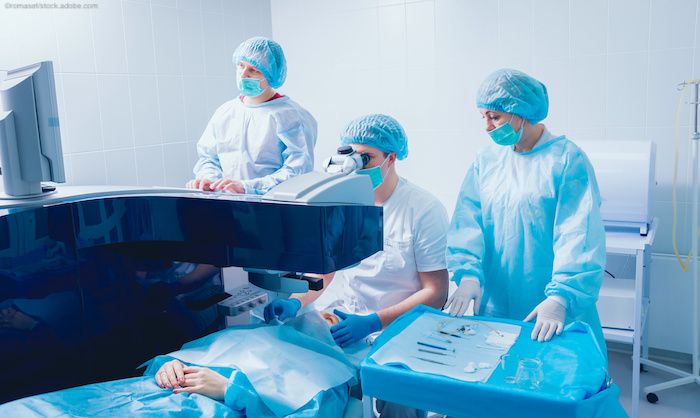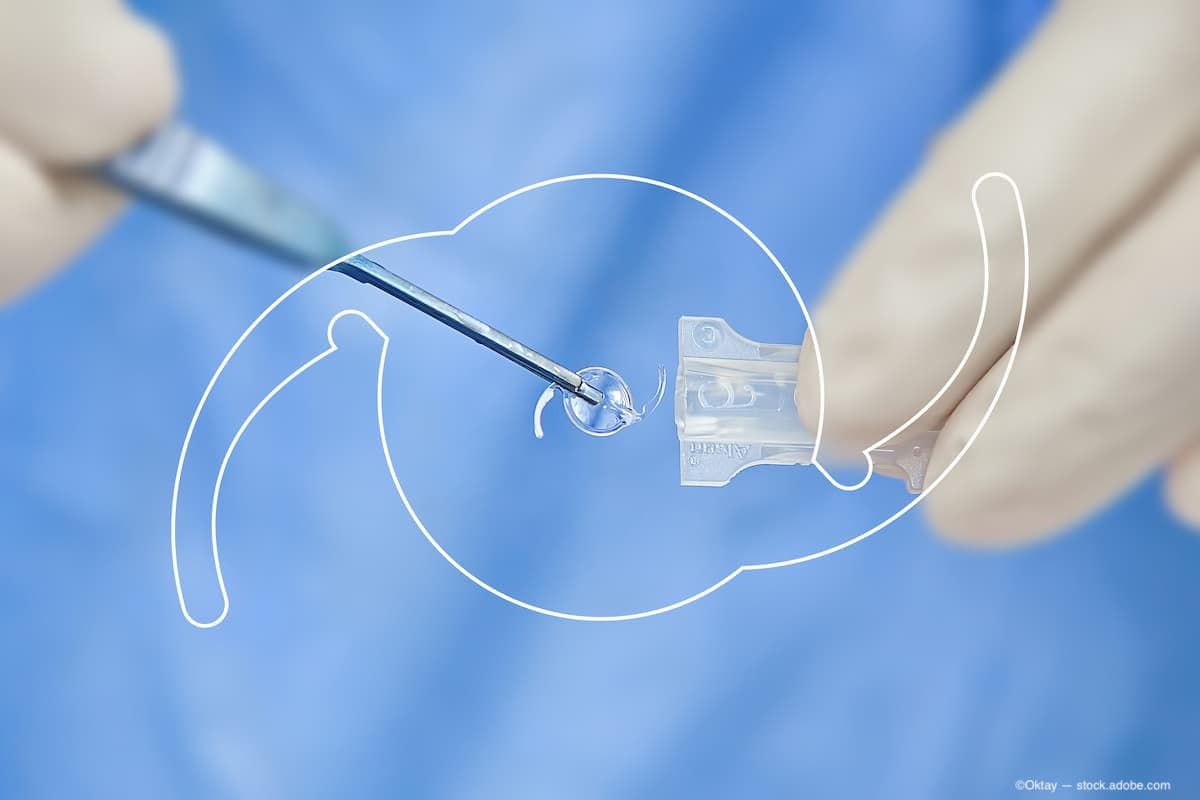Article
Intraoperative aberrometry offers pros, cons for IOL surgical decisions
Author(s):
Robin R. Vann, MD, and Douglas D. Koch, MD, discuss the nuances of the procedure

For some, intraoperative aberrometry offers the opportunity for a more customized approach to IOL decisions and results in better outcomes, whereas others say it is not the optimal solution for achieving consistently better refractive accuracy.
‘Will be the future for achieving better outcomes because it uses a large dataset that can help catch outliers’
Reviewed by Robin R. Vann, MD
Intraoperative aberrometry will become standard in the future because it allows for a more customized approach to IOL decisions and results in better outcomes, said Robin R. Vann, MD. Results of large-scale studies from different countries show that after lens replacement surgery, surgeons are achieving a refractive outcome within 0.5 D of target only 55% to 80% of the time, he said.
“If we are going to do better, we need to think about the very long and very short eyes that are not modeled well in current IOL formulas and about eyes for which values of surgically induced astigmatism (SIA) and posterior corneal astigmatism (PCA) are far outside of the averages used for toric IOL calculations,” said Dr. Vann, medical director, Duke Eye Center Operating Rooms, Durham, NC.
“Intraoperative aberrometry will be the future for achieving better outcomes because it uses a large dataset that can help catch outliers, allows surgeons to incorporate SIA and PCA on a case-bycase basis, and enables outcome tracking and analysis for continued optimization of surgical constants,” he said.
Defining problems
Between 10% and 20% of eyes are outliers on the axial length distribution curve, and therefore, they represent a sizeable subgroup with which surgeons continue to struggle in trying to accurately select spherical IOL power. The ability to predictably minimize astigmatism is limited both by the use of average values for SIA and also PCA in toric IOL calculators.
“With small-incision cataract surgery, SIA can range from 0 to 1 D, but we are not measuring the actual value in each patient,” according to Dr. Vann. “Similarly, the mean magnitude of PCA has been reported to be 0.3 D, but it too can range from 0 to 1 D, and the variability is not accounted for on a case-by-case basis with the use of nomograms,” he said.
Good performance
Dr. Vann reviewed two studies that showed the benefit of using intraoperative aberrometry for improving refractive surgery outcomes. A retrospective study by Cionni et al. analyzing data from more than 32,000 eyes found that the mean absolute prediction error was significantly lower with use of intraoperative aberrometry than without, 0.30 D versus 0.36 D.
Even more interesting were data from eyes in which intraoperative aberrometry recommended an IOL power different than the preoperative plan. In this subset, significantly more eyes had an aberrometry absolute prediction error of ≤0.5 D (81% versus 69%), Dr. Vann noted.
Study offers support
Use of intraoperative aberrometry for optimizing results with toric IOL implantation is supported by results from a study by Woodcock et al.
The study reported refractive astigmatism <0.5% D was achieved in 89% of eyes that had intraoperative aberrometry versus 76% of those for which power selection and alignment were guided by standard calculators and reference marks.
“Intraoperative aberrometry allows surgeons to adjust spherical power of the IOL before placing the implant and to customize toric IOL power and orientation to minimize the amount of residual astigmatism,” Dr. Vann said.
“In cases involving limbal-relaxing incisions, it also provides real-time feedback for adjusting the treatment and reducing astigmatism before the patient leaves the operating room,” he added.
Added advantages
Other benefits of intraoperative aberrometry come from the fact that it has a cloud-based database that serves as a resource for outcomes analysis.
“Surgeons who use the aberrometer can analyze how they are doing over time and compare their outcomes with those of surgeons around the world,” Dr. Vann said.
“With more than 1.2 million cases now entered, the system represents a huge database that can help surgeons improve the accuracy of their outcomes in outliers, and that is a real strength of the system,” he continued.
No ties to IOL technology
He also pointed out that intraoperative aberrometry is agnostic to lens model/manufacturer platforms.
“Using intraoperative aberrometry, surgeons are not tied to certain IOL technologies in order to get great outcomes,” Dr. Vann said.
‘Not the optimal solution for achieving consistently better refractive accuracy’
Reviewed by Douglas D. Koch, MD
Intraoperative aberrometry has been shown to improve refractive outcomes after lens replacement surgery, but only in some studies. Although it may have particular value when surgeons perform more limited preoperative IOL calculations, it is not the optimal solution for achieving consistently better refractive accuracy, according to Douglas D. Koch, MD.
Defending the position that intraoperative aberrometry will not become standard in the future, he cited published reports about its performance and said that logic and practicality also argue against its routine use.
“The outcomes that can be achieved using advanced biometry on an optimized cornea and ever improving IOL formulas will always surpass those attainable with intraoperative aberrometry,” said Dr. Koch, professor and Allen, Mosbacher, and Law Chair in Ophthalmology, Cullen Eye Institute, Baylor College of Medicine, Houston.
Literature review
Eyes with a history of laser refractive surgery present a particular challenge for achieving the refractive target after lens replacement surgery, and published studies investigating a potential benefit of intraoperative aberrometry have provided mixed results. One paper by Ianchulev et al. found that only 67% of 246 eyes achieved a postoperative refraction within 0.5 D of the predicted outcome, which is not very good, said Dr. Koch. Studies by Fram et al. and Fisher and Potvin reported that outcomes achieved with intraoperative aberrometry were neither better nor worse than those associated with the use of standard preoperative calculations.
Little evidence
Analyses of patients operated on at the Cullen Eye Institute also did not provide any evidence supporting the use of intraoperative aberrometry. Reviewing the data, Dr. Koch reported that in a series of 129 eyes with a history of myopic LASIK or PRK, the preoperative predicted IOL power differed from the intraoperative measurement in 97 eyes, of which 57 received an IOL based on intraoperative aberrometry and 40 were implanted according to the preoperative plan.
In the 57 eyes where the IOL was changed based on the intraoperative aberrometry, following guidance of the intraoperative tool turned out to be beneficial only about 50% of the time. In the 40 eyes where the selected IOL was not changed to follow the intraoperative aberrometry recommendation, the outcomes showed that following the preoperative plan was the better decision in about two-thirds of eyes.
“In other words, using the intraoperative aberrometry data in this subset of eyes would have hurt our results,” Dr. Koch said.
The findings were similar in an analysis of 65 eyes with a history of hyperopic LASIK or PRK. In that series, the IOL power suggested by the preoperative calculations differed from intraoperative aberrometry in 51 eyes. It was changed based on the aberrometry in 28 of the 51 eyes, but the switch resulted in an improved outcome only 50% of the time.
The differences
Looking at the 23 eyes where the results of intraoperative aberrometry and the preoperative planning differed and where the eyes were implanted according to the preoperative plan, staying with the original plan was the better decision in more than two-thirds of the cases.
“Again, our results would have been hurt had we followed the intraoperative aberrometry reading in all cases,” Dr. Koch said.
Studies investigating outcomes using intraoperative aberrometry in virgin eyes also report conflicting results, but overall their evidence weighs more against than in favor of intraoperative aberrometry, according to Dr. Koch.
Although a large retrospective study by Cionni et al. recently reported that a significantly higher percentage of eyes had an absolute prediction error ≤0.5 D using intraoperative aberrometry compared with conventional preoperative planning, 82% versus 76%, the 82% rate is lower than what can currently be achieved when surgeons use advanced biometry tools and the latest IOL formulas.
Two other studies focusing on virgin eyes found results using intraoperative aberrometry were no better than with preoperative calculations. Formulas such as the Barrett Universal 2, Hill RBF, and the Olsen ray-tracing formula are now giving us refractive outcomes that are within 0.5 D of target up to 90% of eyes or even more, he said.
The caveat, and an argument in favor of intraoperative aberrometry, is that this type of preoperative measurement requires extensive technician time and surgeon preoperative time analyzing all of the data, Dr. Koch said. Other studies of intraoperative ORA have focused on its use in guiding selection and alignment of toric IOLs.
A study by Woodcock et al. found intraoperative aberrometry outperformed standard power calculation as measured by the percentage of eyes achieving refractive astigmatism ≤0.5 D and comparison of mean residual astigmatism. In contrast, Solomon and Ladas reported a superior result using standard preoperative calculations supplemented with intraoperative markerless registration compared with intraoperative aberrometry.
The performance of intraoperative aberrometry is hampered by the fact that it is measuring a refraction on an eye that has received myriad drops with two or three incisions and sustained operative trauma. “The accuracy of our IOL calculations is still primarily limited by 1) our ability to predict the effective lens position, and 2) the accuracy of our corneal measurements,” Dr. Koch said.
“Essentially, intraoperative aberrometry is trying to predict the effective lens position on an altered eye. “We know that perfection in IOL calculation requires a pristine cornea, and without meeting that condition, intraoperative aberrometry has hit a ceiling in its accuracy, no matter how many datapoints go into its software to refine its performance,” he said.
Intraoperative aberrometry suffers from practical issues that can also serve to limit its adoption, he added.
“Intraoperative aberrometry is a wonderful tool that has served our patients well and will continue to do so for many practices,” Dr. Koch concluded. “However, it is expensive technology, and it, too, takes up surgeon time in the operating room.”
Disclosures:
Robin R. Vann, MD
E: robin.vann@duke.edu
This article was adapted from Dr. Vann’s presentation at the 2018 meeting of the American Academy of Ophthalmology. Dr. Vann is a consultant to Alcon Laboratories.
Douglas D. Koch, MD
E: dkoch@bcm.edu
This article was adapted from Dr. Koch’s presentation at the 2018 meeting of the American Academy of Ophthalmology. He is a consultant to Alcon, Carl Zeiss Meditec, and PerfectLens.
Newsletter
Don’t miss out—get Ophthalmology Times updates on the latest clinical advancements and expert interviews, straight to your inbox.





